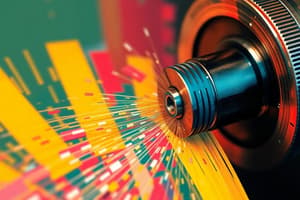Podcast
Questions and Answers
What is the typical RPT range for free-machining steels?
What is the typical RPT range for free-machining steels?
- 0.006 to 0.001 in (correct)
- 0.0012 to 0.0025 in
- 0.020 to 0.025 in
- 0.003 to 0.006 in
Which broaching technique uses notches designed to break the chip?
Which broaching technique uses notches designed to break the chip?
- Progressive broaching
- Standard broaching
- Double-cut design
- Rotor-cut design (correct)
What is the purpose of the back-off angle (γ) in broaching?
What is the purpose of the back-off angle (γ) in broaching?
- To enhance cutting efficiency
- To maintain the structural integrity of the teeth
- To increase the RPT range
- To improve clearance and prevent rubbing (correct)
For effective broaching, how much more material should a workpiece have than the final dimension of the cut?
For effective broaching, how much more material should a workpiece have than the final dimension of the cut?
What is the typical hook (α) angle range for steel during broaching?
What is the typical hook (α) angle range for steel during broaching?
Which of the following is NOT a type of broaching mentioned?
Which of the following is NOT a type of broaching mentioned?
What is the typical RPT range for diameter broaching?
What is the typical RPT range for diameter broaching?
What is the purpose of burnishing teeth in circular broaches?
What is the purpose of burnishing teeth in circular broaches?
What is a significant disadvantage of using a rotary broach compared to push or pull broaches?
What is a significant disadvantage of using a rotary broach compared to push or pull broaches?
How is the number of cutting teeth (n) calculated in a broaching operation?
How is the number of cutting teeth (n) calculated in a broaching operation?
Which condition can cause spiraling during a broaching operation?
Which condition can cause spiraling during a broaching operation?
If a non-integer value for the number of teeth in cut (n) is obtained, what should be done?
If a non-integer value for the number of teeth in cut (n) is obtained, what should be done?
What is the primary factor one must understand regarding the broaching operation's strength variation?
What is the primary factor one must understand regarding the broaching operation's strength variation?
Which of the following must be known to calculate maximum force in a grinding operation?
Which of the following must be known to calculate maximum force in a grinding operation?
In a broaching operation, which condition allows rotary broaching to be superior in some cases?
In a broaching operation, which condition allows rotary broaching to be superior in some cases?
What should be the approach if reversing the rotation of a broaching tool is not feasible?
What should be the approach if reversing the rotation of a broaching tool is not feasible?
Which category does broaching based on its motion belong to?
Which category does broaching based on its motion belong to?
What surface finish can typically be achieved through broaching?
What surface finish can typically be achieved through broaching?
What is the ideal hardness range for steels when broaching?
What is the ideal hardness range for steels when broaching?
Which of the following types of broaches is NOT mentioned in the classifications?
Which of the following types of broaches is NOT mentioned in the classifications?
Which material is considered to have a good machinability rating when broaching?
Which material is considered to have a good machinability rating when broaching?
What is the typical tolerance range achieved through broaching?
What is the typical tolerance range achieved through broaching?
What construction type of a broach can allow for reduced costs when the broach is large enough?
What construction type of a broach can allow for reduced costs when the broach is large enough?
What is a significant limitation when performing internal broaching on a workpiece?
What is a significant limitation when performing internal broaching on a workpiece?
Flashcards are hidden until you start studying
Study Notes
Free Machining Steels
- Typical RPT range for free-machining steels: 150-250
Broaching Techniques
- Notch broaching: A technique using notches to break the chip.
- Back-off angle (γ): Purpose is to provide clearance for the chip to exit the tool.
Effective Broaching - Material Allowance
- Material allowance for broaching: Workpiece should have an allowance of 0.05"-0.1" more material than the final cut dimension for effective broaching.
Broaching Hook Angle
- Hook (α) angle range: Typical range for steel during broaching is 10-20 degrees.
Broaching Types
- Types of broaching: Internal, external, surface
Diameter Broaching
- Typical RPT range for diameter broaching: 100-150
Burnishing Teeth
- Purpose of burnishing teeth in circular broaches: Generate a smooth surface finish.
Rotary Broaches
- Rotary broach disadvantage: Requires a special machine that can rotate the broach, less common than push/pull broaches.
Number of Cutting Teeth
- Calculating the number of cutting teeth (n):
n = (L/s) where L is the length of the cut and s is the feed per tooth.
Spiraling During Broaching
- Spiraling can occur due to uneven engagement between the broach and the workpiece.
Non-Integer Number of Teeth in Cut
- When the number of teeth in cut (n) is not an integer, round it up to the nearest whole number and use a compensating tooth.
Broaching Strength
- The primary factor affecting the broaching operation's strength variation is the broach material and its hardness.
Maximum Force Calculation
- To calculate maximum force in a grinding operation, the cutting force, depth of cut, and grinding wheel width must be known.
Broaching Methods
- Rotary broaching superiority: In cases requiring complex profiles, rotary broaching can be superior to push or pull broaching.
Broaching Tool Reversal
- If reversing the rotation of a broaching tool is not feasible, consider adjusting the feed rate or using a different broaching method.
Broaching Motion Classification
- Broaching is classified as a linear cutting method.
Broaching Surface Finish
- Surface finish achieved through broaching: Typically achieved within the 16-32 RA range.
Broaching Hardness
- Ideal hardness range for steels when broaching: 20-35 HRC
Broaching Types
- Broaching types not mentioned: Continuous, rotary, reciprocating, face.
Machinability Rating
- Free-machining steels are considered to have good machinability when broaching.
Broaching Tolerance
- Typical tolerance range achieved through broaching: 0.001"-0.005"
Broach Construction Costs
- Broach construction using modular design can reduce costs for large broaches.
Internal Broaching Limitation
- Limitation of internal broaching: Limited to smaller internal shapes due to the requirement of a pilot hole.
Studying That Suits You
Use AI to generate personalized quizzes and flashcards to suit your learning preferences.




